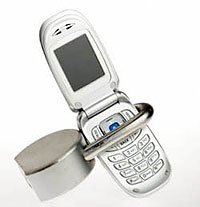There are days when cell phones were locked to one particular service provider. If you tried to leave that company, your phone would not work. It was locked. This phenomenon was so common in Europe and the USA. The purpose of this act was most probably meant to keep one’s clients glued to one’s own network, bearing in mind the mushrooming providers in the same area.


There are days when cell phones were locked to one particular service provider. If you tried to leave that company, your phone would not work. It was locked. This phenomenon was so common in Europe and the USA. The purpose of this act was most probably meant to keep one’s clients glued to one’s own network, bearing in mind the mushrooming providers in the same area.
Sometimes, it was a connivance between the handset manufacturers and the Service providers in that, the handsets were manufactured for a particular network e.g. VODAFONE, ORANGE, CINGULAR etc, these would blocked right from the factory to only work on the network for which they were made.
As if that was not enough, the service providers would require the intending buyers subscribe to their networks and have "free” phones on condition that, they remained on those networks for a year or longer.
Switching networks would not be possible unless you bought a new handset. On the other hand, network locking was seen as a way of controlling the distribution of the phone technology.
Evident to this, NOKIA had some
handsets that only worked in the USA and not in Europe, ASIA and Africa; these came with only the USA & Canada bands only.
It doesn’t have to be this way, though. Depending on what kind of phone you have and what company you purchase cell phone service from, you might be able to unlock your phone.
Then, you’ll have the freedom to use the same phone with different companies, or switch phone numbers and service accounts.
Have you’ve ever wondered what the difference between a locked and an unlocked cell phone is, or if you’ve ever wondered if your phone can be unlocked, or how you can do it.
Having an unlocked phone can be a good thing, is it illegal or not to unlock your phone?
I suppose this depends on where, how and from whom you bought the phone from! SIM cards are small chips about the size of your thumb, but it’s the key to unlocking a locked cell phone.
There are two cell phone technologies that are used by the majority of the world’s mobile phone service providers: Global System for Mobile communication (GSM) and Code Division Multiple Access (CDMA).
If you have a CDMA phone, then your phone is not un-lockable period! However, if your phone operates on a GSM network, then it might be un-lockable.
What’s the difference? GSM phones use subscriber identity module (SIM) cards. A SIM card is a small card that’s inserted into the phone. It contains all your contacts and settings, and it’s linked to your account.
You can take the SIM card out, put it into another phone, and if someone calls your number, the new phone will ring.
You can also put a different SIM card in your unlocked phone, and your phone will then work with whatever phone number and account is linked to that card. CDMA phones have no SIM cards and must be authenticated by the service provider, which makes unlocking a CDMA phone impossible!
If a phone is locked, the service provider has installed some software on the phone that ties the subscriber ID number on the SIM card to the serial number of that particular phone.
If the SIM card and phone serial number don’t match, the phone simply won’t work. The SIM card won’t work in other phones, and the phone won’t work with other SIM cards. This is what is known as "Network Locked Phone”.
Replacing the SIM card in a cell phone is easy, but it only works if the phone is unlocked.
There are two reasons to unlock a phone. First, it gives you the freedom to switch between service providers.
Assuming a long-term service contract doesn’t stand in your way (along with the contract termination fees that come along with it), you can change service providers as often as you like and never have to buy a new phone.
Just put in a new SIM card supplied by your new service provider and your old phone will work just fine. You will have to go through the effort of migrating your old phone number to the new account, however.
The other reason involves travelling to Europe or Asia. If you use your North American phone while travelling, you will rack up enormous roaming fees.
International cell phone companies don’t all rely on the two-year contract business model favoured in the United States.


